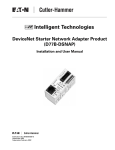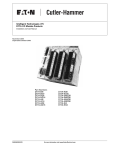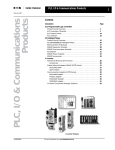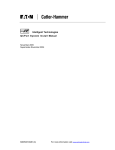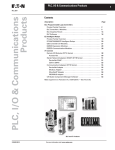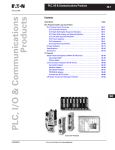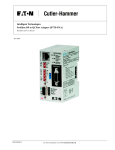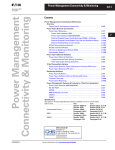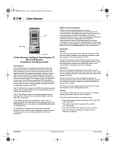Download Eaton Cutler Hammer MN05001002E User manual
Transcript
Intelligent Technologies QCPort Starter Network Adapter Product (QSNAP) Installation and User Manual Publication No. MN05001001E February 2002 New Intelligent Technologies (IT.) QSNAP February 2002 Important Notice – Please Read The product discussed in this literature is subject to terms and conditions outlined in appropriate Eaton’s Cutler-Hammer selling policies. The sole source governing the rights and remedies of any purchaser of this equipment is the relevant Eaton’s Cutler-Hammer selling policy. NO WARRANTIES, EXPRESS OR IMPLIED, INCLUDING WARRANTIES OF FITNESS FOR A PARTICULAR PURPOSE OR MERCHANTABILITY, OR WARRANTIES ARISING FROM COURSE OF DEALING OR USAGE OF TRADE, ARE MADE REGARDING THE INFORMATION, RECOMMENDATIONS AND DESCRIPTIONS CONTAINED HEREIN. In no event will Eaton’s Cutler-Hammer be responsible to the purchaser or user in contract, in tort (including negligence), strict liability or otherwise for any special, indirect, incidental or consequential damage or loss whatsoever, including but not limited to damage or loss of use of equipment, plant or power system, cost of capital, loss of power, additional expenses in the use of existing power facilities, or claims against the purchaser or user by its customers resulting from the use of the information, recommendations and descriptions contained herein. Cover Photo: QSNAP on IT. E101 Starter Pub. No. MN05001001E Intelligent Technologies (IT.) QSNAP February 2002 Table of Contents PRODUCT OVERVIEW Description . . . . . . . . . . . . . . . . . . . . . . . . . . . . . . . . . . . . . . . . . . . . . . . . . . . . . . . . . Features and Benefits . . . . . . . . . . . . . . . . . . . . . . . . . . . . . . . . . . . . . . . . . . . . . . . . Safety . . . . . . . . . . . . . . . . . . . . . . . . . . . . . . . . . . . . . . . . . . . . . . . . . . . . . . . . . . . . . Environmental Ratings . . . . . . . . . . . . . . . . . . . . . . . . . . . . . . . . . . . . . . . . . . . . . . . Approvals/Certifications . . . . . . . . . . . . . . . . . . . . . . . . . . . . . . . . . . . . . . . . . . . . . . Catalog Numbering System . . . . . . . . . . . . . . . . . . . . . . . . . . . . . . . . . . . . . . . . . . . PHYSICAL FEATURES Physical Description . . . . . . . . . . . . . . . . . . . . . . . . . . . . . . . . . . . . . . . . . . . . . . . . . Dimensions . . . . . . . . . . . . . . . . . . . . . . . . . . . . . . . . . . . . . . . . . . . . . . . . . . . . . . . . Power Source. . . . . . . . . . . . . . . . . . . . . . . . . . . . . . . . . . . . . . . . . . . . . . . . . . . . . . . OPERATION “Out of Box” Operation . . . . . . . . . . . . . . . . . . . . . . . . . . . . . . . . . . . . . . . . . . . . . . Typical Application . . . . . . . . . . . . . . . . . . . . . . . . . . . . . . . . . . . . . . . . . . . . . . . . . . Enhanced Features . . . . . . . . . . . . . . . . . . . . . . . . . . . . . . . . . . . . . . . . . . . . . . . . . . Input/Output Data . . . . . . . . . . . . . . . . . . . . . . . . . . . . . . . . . . . . . . . . . . . . . . . . . . . Input Data . . . . . . . . . . . . . . . . . . . . . . . . . . . . . . . . . . . . . . . . . . . . . . . . . . . . . Output Data . . . . . . . . . . . . . . . . . . . . . . . . . . . . . . . . . . . . . . . . . . . . . . . . . . . . Status LED . . . . . . . . . . . . . . . . . . . . . . . . . . . . . . . . . . . . . . . . . . . . . . . . . . . . . . . . . Truth Table . . . . . . . . . . . . . . . . . . . . . . . . . . . . . . . . . . . . . . . . . . . . . . . . . . . . . . . . . CONFIGURATION Using CH Studio . . . . . . . . . . . . . . . . . . . . . . . . . . . . . . . . . . . . . . . . . . . . . . . . . . . . INSTALLATION Set the Group ID . . . . . . . . . . . . . . . . . . . . . . . . . . . . . . . . . . . . . . . . . . . . . . . . . . . . SW1 Settings . . . . . . . . . . . . . . . . . . . . . . . . . . . . . . . . . . . . . . . . . . . . . . . . . . . . . . . Mount the IT. QSNAP to the Starter. . . . . . . . . . . . . . . . . . . . . . . . . . . . . . . . . . . . . Wire the IT. QSNAP to the Starter . . . . . . . . . . . . . . . . . . . . . . . . . . . . . . . . . . . . . . Connect the QSNAP to QCPort. . . . . . . . . . . . . . . . . . . . . . . . . . . . . . . . . . . . . . . . . TROUBLESHOOTING AND MAINTENANCE Renewal Parts . . . . . . . . . . . . . . . . . . . . . . . . . . . . . . . . . . . . . . . . . . . . . . . . . . . . . . Troubleshooting . . . . . . . . . . . . . . . . . . . . . . . . . . . . . . . . . . . . . . . . . . . . . . . . . . . . APPENDIX A: QSNAP PARAMETERS. . . . . . . . . . . . . . . . . . . . . . . . . . . . . . . . . . . . . . . . INTELLIGENT TECHNOLOGIES (IT.) PUBLICATIONS AND SUPPORT . . . . . . . . . . . . . . Pub. No. MN05001001E 1 2 3 4 4 4 5 5 6 8 9 10 11 11 12 13 13 14 15 16 16 18 19 20 20 21 23 i Intelligent Technologies (IT.) QSNAP February 2002 List of Figures Figure 1: QSNAP Features . . . . . . . . . . . . . . . . . . . . . . . . . . . . . . . . . . . . . . . . . . . . . Figure 2: QSNAP Dimensions, mm [in] . . . . . . . . . . . . . . . . . . . . . . . . . . . . . . . . . . Figure 3: Starter Interface Connection . . . . . . . . . . . . . . . . . . . . . . . . . . . . . . . . . . . Figure 4: Typical QSNAP Application . . . . . . . . . . . . . . . . . . . . . . . . . . . . . . . . . . . . Figure 5: Group ID Setting. . . . . . . . . . . . . . . . . . . . . . . . . . . . . . . . . . . . . . . . . . . . . Figure 6: QSNAP with 54 mm IT. Starter . . . . . . . . . . . . . . . . . . . . . . . . . . . . . . . . . Figure 7: QSNAP Alignment and Mounting. . . . . . . . . . . . . . . . . . . . . . . . . . . . . . . Figure 8: QSNAP Removal. . . . . . . . . . . . . . . . . . . . . . . . . . . . . . . . . . . . . . . . . . . . . Figure 9: Jumper and RJ-45 Plug . . . . . . . . . . . . . . . . . . . . . . . . . . . . . . . . . . . . . . . Figure 10: Jumper Installation . . . . . . . . . . . . . . . . . . . . . . . . . . . . . . . . . . . . . . . . . Figure 11: QCPort Connection. . . . . . . . . . . . . . . . . . . . . . . . . . . . . . . . . . . . . . . . . . Figure 12: QCPort Wiring Diagram . . . . . . . . . . . . . . . . . . . . . . . . . . . . . . . . . . . . . . 5 5 6 9 15 16 17 17 18 18 19 19 Table 1: QSNAP Electromechanical Starter Connectivity Table . . . . . . . . . . . . . . . Table 2: QSNAP S751 Connectivity Table. . . . . . . . . . . . . . . . . . . . . . . . . . . . . . . . . Table 3: Environmental Ratings . . . . . . . . . . . . . . . . . . . . . . . . . . . . . . . . . . . . . . . . Table 4: Approvals/Certifications . . . . . . . . . . . . . . . . . . . . . . . . . . . . . . . . . . . . . . . Table 5: Power Requirements . . . . . . . . . . . . . . . . . . . . . . . . . . . . . . . . . . . . . . . . . . Table 6: Default Input Data from QSNAP . . . . . . . . . . . . . . . . . . . . . . . . . . . . . . . . . Table 7: Default Output Data to QSNAP . . . . . . . . . . . . . . . . . . . . . . . . . . . . . . . . . . Table 8: Standard Features . . . . . . . . . . . . . . . . . . . . . . . . . . . . . . . . . . . . . . . . . . . . Table 9: Enhanced Features . . . . . . . . . . . . . . . . . . . . . . . . . . . . . . . . . . . . . . . . . . . Table 10: Input Assembly Data Definitions . . . . . . . . . . . . . . . . . . . . . . . . . . . . . . . Table 11: Default Input Data . . . . . . . . . . . . . . . . . . . . . . . . . . . . . . . . . . . . . . . . . . . Table 12: Default Output Data . . . . . . . . . . . . . . . . . . . . . . . . . . . . . . . . . . . . . . . . . . Table 13: Output Assembly Data Definitions . . . . . . . . . . . . . . . . . . . . . . . . . . . . . . Table 14: Status LED. . . . . . . . . . . . . . . . . . . . . . . . . . . . . . . . . . . . . . . . . . . . . . . . . . Table 15: QSNAP Truth Table . . . . . . . . . . . . . . . . . . . . . . . . . . . . . . . . . . . . . . . . . . Table 16: SW1 Settings . . . . . . . . . . . . . . . . . . . . . . . . . . . . . . . . . . . . . . . . . . . . . . . Table 17: Starter Size/Available Auxiliary Locations on Mounted QSNAP . . . . . . Table 18: Terminal Block Wiring . . . . . . . . . . . . . . . . . . . . . . . . . . . . . . . . . . . . . . . . Table 19: QSNAP Renewal Parts . . . . . . . . . . . . . . . . . . . . . . . . . . . . . . . . . . . . . . . . Table 20: Troubleshooting . . . . . . . . . . . . . . . . . . . . . . . . . . . . . . . . . . . . . . . . . . . . . Table 21: Configuration Parameters . . . . . . . . . . . . . . . . . . . . . . . . . . . . . . . . . . . . . Table 22: Data Parameters . . . . . . . . . . . . . . . . . . . . . . . . . . . . . . . . . . . . . . . . . . . . . Table 23: IT. Publications . . . . . . . . . . . . . . . . . . . . . . . . . . . . . . . . . . . . . . . . . . . . . . 1 1 4 4 6 8 8 10 10 11 12 12 12 13 13 16 16 18 20 20 21 22 23 List of Tables ii Pub. No. MN05001001E Intelligent Technologies (IT.) QSNAP February 2002 Product Overview Description Cutler-Hammer Intelligent Technologies (IT.) QSNAP (QCPort Starter Network Adapter Product) by Eaton Corporation is the result of a substantive engineering and marketing effort, involving extensive customer input. This product has greatly increased functionality of the Eaton’s Cutler-Hammer Intelligent Technologies (IT.) Electromechanical Starter with the addition of enhanced features, such as jam, stall and underload. This single front-mount device is a single QCPort™ (Quick Connect Port) device providing control and monitoring of Intelligent Technologies (IT.) Electromechanical Starter application. The QSNAP product line provides communication capability to the following Intelligent Technologies (IT.) Electromechanical Starters. Table 1: QSNAP Electromechanical Starter Connectivity Table Amperage Rating IEC E101 E501 Frame Size NEMA N101 N501 Frame Size 18 Amp B 45 mm 00 45 mm 25 Amp 0 32 Amp 40 Amp C 54 mm 1 54 mm D 76 mm 2 76 mm E 105 mm 3 105 mm 50 Amp 65 Amp 85 Amp 100 Amp 125 Amp 160 Amp 4 200 Amp 250 Amp F 140 mm 5 140 mm 315 Amp 400 Amp Table 2: QSNAP S751 Connectivity Table S751 All This manual specifically addresses the QCPort Starter Network Adapter Product (QSNAP). For further information on the IT. family of devices, visit our Web site at: www.cutler-hammer.eaton.com/it Notice Because the IT. Starters use 24V DC for control and power, the QSNAP can only be applied with the IT. family of starters. Pub. No. MN05001001E 1 Intelligent Technologies (IT.) QSNAP February 2002 Features and Benefits The IT. QSNAP includes the following significant features: 2 ● Communication to QCPort consuming a single QCPort ID ● Control of non-reversing and reversing Eaton’s Cutler-Hammer Intelligent Technologies (IT.) Electromechanical Starters ● Monitoring of non-reversing and reversing Eaton’s Cutler-Hammer Intelligent Technologies (IT.) Electromechanical Starters ● Direct mounting to the front of Eaton’s Cutler-Hammer Intelligent Technologies (IT.) Electromechanical Starter ● Connection to an auxiliary ground fault detector ● Sensing of the second contactor ● Manually set Group ID; configuration using a software application is not required for normal operation ● Enhanced features, such as jam and stall detection and nuisance trip avoidance ● Warning levels that are user-settable ● Settable current threshold alarm Pub. No. MN05001001E Intelligent Technologies (IT.) QSNAP February 2002 Safety The following safety statements relate to the installation, setup and operation of Eaton’s Cutler-Hammer IT. QSNAP and Starter. Notice Make sure you read and understand the installation procedures in this manual before you attempt to operate or set up the equipment. WARNING This instruction manual should be used for proper installation, setup and operation of the IT. QSNAP. Improperly installing and maintaining this product can result in serious personal injury or property damage. Before attempting installation, setup or operation, read and understand this entire manual. WARNING Hazardous voltage can cause electric shock and burns. Always disconnect power before proceeding with any work on this product. CAUTION Only apply 24V DC to the QSNAP power terminals. Use of any other voltage may result in personal injury, property damage and damage to the IT. QSNAP. WARNING To provide continued protection against fire or shock hazard, the complete IT. QSNAP must be replaced if it becomes inoperative. Pub. No. MN05001001E 3 Intelligent Technologies (IT.) QSNAP February 2002 Environmental Ratings The following environmental ratings apply to the QSNAP. Table 3: Environmental Ratings Category Description Specification Transportation Temperature -50°C to 80°C [-58°F to 176°F] Humidity 95% non-condensing Temperature -50°C to 80°C [-58°F to 176°F] Humidity 95% non-condensing Temperature -30°C to 55°C [-22°F to 131°F] Humidity 95% non-condensing Altitude Above 2000 meters [6600 feet] consult factory Shock 15 g’s half-wave sinusoidal 11 msecs Vibration 5 – 57.5 Hz (100 – 17 msecs) @ 0.3 mm SA Storage Operating 57.5 – 150 Hz (17 – 6.7 msecs) @ 0.35 mm SA Enclosure IP20 Approvals/Certifications The following approvals and certifications apply to the QSNAP. Table 4: Approvals/Certifications Standard Approval/Certification UL UL508 CE CSA CSAC22.2 No. 14-95 Catalog Numbering System There is only one catalog number for QCPort connection to Eaton’s Cutler-Hammer Intelligent Technologies (IT.) Electromechanical Starters. These starters include those listed in Table 1 on Page 1. The catalog number is QSNAP. This part number includes the QSNAP and the starter interface board that connects the starter and the QSNAP. Note: When ordering QSNAP for Full Voltage Reversing, consult factory for the QSNAP Auxiliary contact and jumper catalog numbers. Note: When ordering a ground fault detector, consult factory for catalog number. 4 Pub. No. MN05001001E Intelligent Technologies (IT.) QSNAP February 2002 Physical Features Physical Description Figure 1 illustrates the front and back of the IT. QSNAP and its various features. Group ID Switch Feet Contactor Detector Connector Breakout Lock Starter Connector Lock Tab Status LED Figure 1: QSNAP Features Dimensions Figure 2 illustrates the dimensions of the IT. QSNAP. Front Side 26 [1.0] 32 [1.3] 62 [2.4] Figure 2: QSNAP Dimensions, mm [in] Pub. No. MN05001001E 5 Intelligent Technologies (IT.) QSNAP February 2002 Power Source The IT. QSNAP is designed for use with 24V DC power. The QSNAP uses power from two sources when operating properly; these sources are the QCPort subnet and the Eaton’s Cutler-Hammer Intelligent Technologies (IT.) Electromechanical Starter. This allows the QSNAP to detect and communicate to the user that the IT. starter does not have 24V DC power, signaling a fault or an E-Stop. The main power that powers the communication is from QCPort, as illustrated in Table 5. Some power is required from the starter for communication to be present between the Intelligent Technologies (IT.) Electromechanical Starter and the QSNAP. The power for the IT. starter must be connected to the starter terminal. Table 5: Power Requirements Current Source Load QCPort TBD IT. Starter TBD When a power supply is chosen for QCPort, take into account the load on QCPort. When a power supply is chosen for the starter(s), size it for the load of the starter(s) using the IT. Contactor and Starter User Manual (Publication No. 49400). Refer to the IT. QCPort System Install and Planning Guide (Publication No. MN05001002E) for more information on how to size the power supply for the QCPort system. The power for the Eaton’s Cutler-Hammer Intelligent Technologies (IT.) Electromechanical Starter must be connected to the Intelligent Technologies (IT.) Electromechanical Starter terminal, as illustrated in Figure 3. To Starter + 24V DC – Optional E-Stop To QSNAP Figure 3: Starter Interface Connection 6 Pub. No. MN05001001E Intelligent Technologies (IT.) QSNAP February 2002 CAUTION Only apply 24V DC to the QSNAP. Use of any other voltage may result in personal injury, property damage and damage to the QSNAP. Pub. No. MN05001001E 7 Intelligent Technologies (IT.) QSNAP February 2002 Operation This section provides details about the following features and aspects of QSNAP operation: ● “Out of box” operation ● Typical application ● Enhanced features ● Input/output data ● Status LED ● Truth table “Out of Box” Operation When the QSNAP is properly installed and has a properly configured Group ID, as per the “Installation” section, the following default data lists will be presented to the system for use by a gateway. For further information on the meaning of the terms in the assemblies, see the “Enhanced Features” section on Page 10. Table 6: Default Input Data from QSNAP Bit 7 Bit 6 Bit 5 Bit 4 Bit 3 Bit 2 Bit 1 Bit 0 3-Phase Average RMS Current LSB Byte 0 3-Phase Average RMS Current Byte 1 3-Phase Average RMS Current Byte 2 3-Phase Average RMS Current MSB Byte 3 % Thermal Capacity LSB Byte 4 % Thermal Capacity MSB Byte 5 Fault/Warning Codes LSB Byte 6 Fault/Warning Codes MSB Reserved Warning Faulted Local Control Byte 7 Resetting Permissive Running 2 Running 1 Bit 4 Bit 3 Bit 2 Bit 0 Local/ Remote Fault Reset Permissive Run 2 Byte 8 Table 7: Default Output Data to QSNAP 8 Bit 7 Bit 6 Bit 5 Reserved Reserved Local Control Bit 1 Run 1 Byte 8 Pub. No. MN05001001E Intelligent Technologies (IT.) QSNAP February 2002 Typical Application The following figure illustrates a typical QSNAP application, where a single QSNAP is connected to one motor controller and where the motor controllers are distributed throughout QCPort. The subnet is then being controlled by a PC or PLC, which scans the D77D-DNA DeviceNet Adapter, retrieving the QSNAP’s control and monitoring information. D77D-DNA D77A-IO D77A-IO IT. Starters with QSNAPs To Control PC or PLC 24V DC IT. Supply QCPort Figure 4: Typical QSNAP Application Note: Such an application has more devices on QCPort than are shown in this illustration, such as drives and user interface units. Pub. No. MN05001001E 9 Intelligent Technologies (IT.) QSNAP February 2002 Enhanced Features The QSNAP offers a variety of enhanced features, including: settable warnings, current threshold warning, underload warning and reset. To help diagnose an application, a fault queue is provided to view the last five faults. Refer to the following two tables for definitions of the QSNAP Enhanced Features and Threshold Features. Table 8: Standard Features Fault Definition Phase Current A phase current unbalance trip will occur if one or two of the line currents are Unbalance/Phase Loss 40 – 60% or less of the remaining line(s) for longer than 10 seconds. A phase loss trip will occur with a load current of at least 75% of the minimum FLA if one of the two input line voltages is lost, with the line current going to zero for longer than 10 seconds. Thermal Overload While the motor is running and depending on the FLA and trip class settings, when the FLA is exceeded for a period of time (depending on the trip class setting), a thermal overload trip will occur. For more information on this feature, see the IT. Contactor and Starter User Manual (Publication No. 49400). Table 9: Enhanced Features Fault Definition Ground Fault With the addition of a Ground Fault module, the QSNAP will trip when the module detects a ground fault. To set the level of the trip, a setting is adjusted on the Ground Fault Module. The Ground Fault Module is connected to the QSNAP through the Auxiliary opening on the face of the QSNAP. Underload Warning While the motor is running, a warning will be activated when the current falls below a user settable % of FLA. Current Threshold Warning While the motor is running, a warning will be activated when the current rises above a user settable % of FLA. Note: The threshold values for Thermal Overload and Phase Current Unbalance can not be modified. 10 Pub. No. MN05001001E Intelligent Technologies (IT.) QSNAP February 2002 Input/Output Data The QSNAP offers a standard data list (shown below) for default operation. The list is configurable with data contained within Table 21 in Appendix A: QSNAP Parameters, using the CH Studio application. Input Data Use Tables 10 and 11 when setting up the QSNAP input data. Table 10: Input Assembly Data Definitions Pub. No. MN05001001E Data Description Faulted/Trip The motor controller is faulted or tripped Warning The motor controller has a warning of an impending trip Running 1 The first motor controller is running Running 2 The second motor controller is running Permissive The motor controller run/stop permissive Resetting Motor controller is in the process of resetting a fault Thermal Capacity % thermal capacity of the motor from 0 to 100% RMS Average Current Average RMS current of the motor (0.000A) Fault Codes and Warning Codes Valid fault and warning codes are: 0 No Fault 1 General Fault 2 Firmware Fault 3 Interdevice Communication Fault 4 Control Voltage Low Fault 5 Control Device Overtemperature Fault 6 Motor Phase Loss Fault 7 Motor Phase Imbalance Fault 8 Motor Ground Fault 9 Motor Underload Fault 10 Motor Overcurrent Fault 13 Motor Bypass Failure Fault 14 Motor Thermal Pile Fault 15 Control Device Test Fault 40000 Current Threshold Warning 40001 Underload Warning 40002 Control Device Overtemperature Warning 40003 Overload Warning 11 Intelligent Technologies (IT.) QSNAP February 2002 Table 11: Default Input Data Bit 7 Bit 6 Reserved Warning Bit 5 Bit 4 Bit 3 Bit 2 Bit 1 Bit 0 3-Phase Average RMS Current LSB Byte 0 3-Phase Average RMS Current Byte 1 3-Phase Average RMS Current Byte 2 3-Phase Average RMS Current MSB Byte 3 % Thermal Capacity LSB Byte 4 % Thermal Capacity MSB Byte 5 Fault/Warning Codes LSB Byte 6 Fault/Warning Codes MSB Byte 7 Faulted Local Control Resetting Permissive Running 2 Running 1 Byte 8 Output Data Use Tables 12 and 13 when setting up the QSNAP output data. Table 12: Default Output Data Bit 7 Bit 6 Bit 5 Bit 4 Bit 3 Bit 2 Bit 1 Reserved Reserved Local Control Local / Remote Fault Reset Permissive Run 2 Bit 0 Run 1 Byte 8 Table 13: Output Assembly Data Definitions 12 Data Description Run 1 Energize the first starter when Permissive is 1 Run 2 Energize the second starter when Permissive is 1 Fault Reset Reset the fault Permissive Starter Permissive, O – Stops the starter, I – Enables to run the starter Pub. No. MN05001001E Intelligent Technologies (IT.) QSNAP February 2002 Status LED The status LED is located on the lower right of the QSNAP as pictured in Figure 1: QSNAP Features. The LED’s status changes depending on the state of the QSNAP. The following table lists the IT. QSNAP LED statuses and describes the meaning of each state. Table 14: Status LED State LED Behavior No Power OFF Power-Up Routine OFF – CRC corrupt Waiting for a member ID, power-up OK (mostly off) Received a member ID, off-line (slow blink) On-line (mostly on) Faulted (fast blink) Identify device (burst) Truth Table Table 15: QSNAP Truth Table Fieldbus Inputs Old State Run 1 Run 2 Reset Event New State Action FAULTED – – 1 RESET OFF FAULT = 0 OFF 0 0 – NONE OFF NONE OFF 1 0 – RUN 1 RUNNING 1 RUNNING 1 = 0 OFF 0 1 – RUN 2 RUNNING 2 RUNNING 2 = 0 RUNNING 1 1 1 – RUN 2 RUNNING 1 NONE RUNNING 2 1 1 – RUN 1 RUNNING 2 NONE RUNNING 1 1 1 – RUN 1 removed RUNNING 2 RUNNING 1 = 0, RUNNING 2 = 1 RUNNING 2 1 1 – RUN 2 removed RUNNING 1 RUNNING 1 = 1, RUNNING 2 = 0 RUNNING 1 1 0 – FAULT OFF RUNNING 1 = 0 READY = 0 RUNNING 2 0 1 – FAULT OFF RUNNING 2 = 0 READY = 0 RUNNING 1 1 0 – WARNING RUNNING 1 RUNNING 1 = 1 WARNING = 1 RUNNING 2 0 1 – WARNING RUNNING 2 RUNNING 2 = 1 WARNING = 1 – = state not important 1 = state true (energized) 0 = state false (de-energized) WARNING = Running Current > FLA but not tripped Pub. No. MN05001001E READY = 1 RUNNING 1 = Run/FWD/SLOW RUNNING 2 = REV/FAST FAULT = GND FLT and/or OL TRIP 13 Intelligent Technologies (IT.) QSNAP February 2002 Configuration The only configuration that is necessary for normal operation of the QSNAP is setting the Group ID and SW1 positions A and B, as described in the “Installation” section. However, the QSNAP offers a variety of enhanced features. When these features are required, use the CH Studio application or a tool that can read an EDS file to perform the configuration. Using CH Studio The CH Studio software application is designed for programming and configuring industrial automation systems. The application simplifies the monitoring and configuration of entire networks as well as the enhanced features of individual IT. communicating devices within those networks. CH Studio takes advantage of the Windows graphical interface to present a suite of tools that is easy to learn and efficient to use, while meeting the requirements for developing complex network configurations. CH Studio performs the following configuration functions for DeviceNet and QCPort networks: 14 ● Discover network devices ● Display device properties ● Monitor and configure network devices ● Save existing network configurations ● Configure networks off-line ● Configure devices off-line Pub. No. MN05001001E Intelligent Technologies (IT.) QSNAP February 2002 Installation Set the Group ID The Group ID refers to the logical QCPort group to which the QSNAP belongs. For further information on the explanation of Group ID and the system configuration, see the IT. QCPort System Install and Planning Guide (Publication No. MN05001002E). The Group ID and SW1 A and B DIP switches are located at the upper right of the QSNAP, as illustrated in Figure 5: Group ID Setting. CH Studio can view the settings for the Group ID, but cannot be used to modify them. Move the DIP switches to ON/OFF positions to create the Group ID. Moving a DIP switch to the right is ON and moving the switch to the left is OFF. The Group ID is in binary with the major units numbered to the right of the switch on the side label. Adding up the major units set to ON determines the Group ID of the QSNAP. Example: To set the Group ID to 25, start from the top (or 32) and set the switches to OFF, ON, ON, OFF, OFF, ON (16+8+1=25). 32 16 8 4 Group ID 2 1 A SWI B OFF (0) Figure 5: Group ID Setting When a gateway is present and presenting the QSNAP as remote IO, each device on the QCPort must have a unique Group ID. If any two like QCPort devices have the same Group ID, those devices will go off-line. Refer to the appropriate gateway install manual for information on the data packet construction for that fieldbus (IT. DeviceNet Adapter Installation and User Manual, Publication No. MN05004002E). Once the Group ID is set, a power cycle is not required; after five seconds of inactivity of the switches, the change takes effect. The Status LED indicates if the QSNAP is properly configured; the LED is located on the lower right of the QSNAP, as illustrated in Figure 6: QSNAP with 54 mm IT. Starter. For more information on the LED, see “Operation.” Pub. No. MN05001001E 15 Intelligent Technologies (IT.) QSNAP February 2002 SW1 Settings SW1 is used to set the existence of the second Aux contact and the external ground fault. Table 16: SW1 Settings SW1 Position Event A 0 = no second Aux installed, 1 = second Aux installed B 0 = no ground fault installed, 1 = ground fault installed Mount the IT. QSNAP to the Starter The IT. QSNAP is designed to be installed in the auxiliary contact locations of the IT. family of starters as illustrated in Figure 6. On all starters, one or more auxiliaries can be used along with the QSNAP. Table 17 lists starters and indicates the number of available auxiliary locations for each. Table 17: Starter Size/Available Auxiliary Locations on Mounted QSNAP Starter Frame Size (mm) Number of Available Auxiliary Locations when Center Mounted 45 1 single 54 1 single or 1 dual 76 2 single or 2 dual 105 2 single or 2 dual 140 2 single or 2 dual Figure 6: QSNAP with 54 mm IT. Starter 16 Pub. No. MN05001001E Intelligent Technologies (IT.) QSNAP February 2002 Use the following steps and the illustration in Figure 7 to mount the QSNAP. 1. Align both the QSNAP feet with the auxiliary contact mounting slots on the starter, as illustrated in the figure. Recommendation: Use the middle mounting auxiliary contact on the contact block when mounting the QSNAP. 2. When the QSNAP is aligned, insert the feet into the detents and slide the QSNAP towards the overload until a “click” is heard. This ensures that the QSNAP is mounted securely to the starter. 1. Align and Insert 2. Slide Figure 7: QSNAP Alignment and Mounting Note: To remove the QSNAP, press the “PUSH” tab protruding from the QSNAP while sliding the QSNAP up and pulling away from the contactor block, as illustrated in Figure 8. 1. Slide 2. Pull Away Figure 8: QSNAP Removal Pub. No. MN05001001E 17 Intelligent Technologies (IT.) QSNAP February 2002 Wire the IT. QSNAP to the Starter The QSNAP is connected to the IT. starter using a factory-provided jumper with an RJ-45 plug on one end and a pigtail on the other. The pigtail is color coded to facilitate accurate connection to the overload terminal block. Refer to the following figure and table when wiring the terminal block. RJ-45 Plug 1 1 1 Figure 9: Jumper and RJ-45 Plug Table 18: Terminal Block Wiring Starter RJ-45 GND 1 +24 2 P 3 F 4 R 5 1 6 2 7 3 8 Use the following steps and illustrations to install the jumper. 1. Once the jumper is wired, insert the terminal block into the overload and the RJ-45 connector into J3 on the QSNAP as illustrated in Figure 10: Jumper Installation. QSNAP Jumper IT. Starter Terminal Block Figure 10: Jumper Installation 18 Pub. No. MN05001001E Intelligent Technologies (IT.) QSNAP February 2002 2. To lock the starter interface to the overload, rotate the orange locking tabs until the tab is locked into the slots in the overload. Use Figure 11 for information on which way to rotate the locking tabs. Note: Refer to the IT. Contactor and Starter User Manual (Publication No. 49400) for more information on locking and unlocking the terminal block to the starter. Connect the QSNAP to QCPort The connection to QCPort consists of using the QCPort interconnect jumper from the second port of the upstream device and connecting it to J1 on the QSNAP. The downstream QCPort device then connects to J2 on the QSNAP as in Figure 11: QCPort Connection. Use the following wiring diagram and illustration to connect the QSNAP to QCPort. Figure 11: QCPort Connection 1 1 1 2 3 4 5 6 – – – – – – +24 G B A +24 G Figure 12: QCPort Wiring Diagram Use one of the pre-manufactured cables for connecting between QCPort devices. If a custom cable is to be made, follow the guidelines for cable specifications and connector types listed in IT. QCPort System Install and Planning Guide (Publication No. MN05001002E). Pub. No. MN05001001E 19 Intelligent Technologies (IT.) QSNAP February 2002 Troubleshooting and Maintenance Renewal Parts The renewal parts for the QSNAP are shown in the following table. Table 19: QSNAP Renewal Parts Description Part Number J3 Jumper Consult Factory Starter Interface Consult Factory Auxiliary Contact Consult Factory Ground Fault Detector Consult Factory Auxiliary Plug Consult Factory Troubleshooting Table 20: Troubleshooting Observation Possible Cause/Corrective Action IT. starter attempts to energize when RUN is commanded but will not stay in Check 24V DC coil power supply. IT. starter will not energize Control terminal block is not seated or connected properly on overload or customer wiring. Check 24V DC control power supply. Verify that the permissive bit is = 1. Check J3 wiring. Make sure there is not a trip. Reversing starter will not energize Unit already running in forward. The units are electrically and mechanically interlocked. Check J3 wiring. 20 Reversing starter will not energize but forward does Check J3 wiring. IT. starter automatically energizes on power-up Check J3 wiring. Reversing interlock is jammed. Pub. No. MN05001001E Intelligent Technologies (IT.) QSNAP February 2002 Appendix A: QSNAP Parameters Refer to the following table when configuring the QSNAP. Table 21: Configuration Parameters Number Parameter Length 1 Config Data 14 2 Configuration CRC check 2 3 Node ID 2 4 QCPort mode 1 5 Baud Rate 1 6 Slave Address 1 7 Production Dest 2 8 Device ID Tag 16 9 Prod Int 2 10 Cons Int 2 11 Parameter List 0 12 Production List 0 13 Consumption List 0 32 Overload Trip FLA Value 4 33 Overload Trip Class Value 1 Class 34 Percent Initial Torque 1 % 37 Motor Start Ramp Time 2 mS 38 Motor Stop Ramp Time 2 mS 43 Current Threshold Warning Threshold 1 En/Dis 44 Current Threshold Warning Threshold 1 % 46 Current Threshold Warning Debounce 2 mS 51 Motor Underload Warning Level 1 En/Dis 52 Motor Underload Warning Level 1 % 54 Motor Underload Warning Debounce 2 mS 55 Motor Ground Fault Enable 1 En/Dis 56 Motor Ground Fault Debounce Time 2 mS 57 Motor Ground Fault Inhibit From Start Delay Enable 1 En/Dis 58 Motor Ground Fault Inhibit From Start Delay 1 S Pub. No. MN05001001E Units Amps 21 Intelligent Technologies (IT.) QSNAP February 2002 Table 22: Data Parameters Number Parameter 11 Motor Control 1 12 Motor Control Status 1 13 Motor Control Faults 2 14 Button State 1 15 LED State 1 16 ASCII Text 1 18 RMS AC Current Amps 4 22 Control DC Voltage Amps 2 23 Thermal Pile Percentage Volts 2 24 Temperature Deg C % 2 26 Fault Quene Hz 2 22 Units Length Pub. No. MN05001001E Intelligent Technologies (IT.) QSNAP February 2002 Intelligent Technologies (IT.) Publications and Support Table 23: IT. Publications Publication Description MN05002001E IT. D77A- IO Module Products Installation and Users Manual MN05001002E IT. QCPort System Install and Planning Guide MN05001001E IT. QCPort Starter Network Adapter Product (QSNAP) Installation and Users Manual Pub 4960 IT. Overload Relay Setup and Troubleshooting Guide Pub 49601 IT. Overload Relay Quick Setup Guide MN05004001E IT. DeviceNet Starter Network Adapter Product (DSNAP) Installation and Users Manual MN05004002E IT. DeviceNet Adapter Installation and User Manual Pub 49907 Intelligent Technologies S751 Soft Starter User Manual For copies of these and other publications contact the Literature Fulfillment Center at 1-800-957-7050. Pub. No. MN05001001E 23 Intelligent Technologies (IT.) QSNAP February 2002 24 Pub. No. MN05001001E Eaton’s Cutler-Hammer Aftermarket Services • • • • • • Technical/telephone support Resident service engineers in major trading centers Factory repair services Warranty administration Equipment modification and upgrading services Training seminars For additional information on this product, please call our Customer Support Center at: 1-800-356-1243 For service or start-up assistance 24 hours/day, 7 days/week, please call: 1-800-498-2678 A response network that gives new meaning to customer service • Personalized • Comprehensive • Professional Eaton Corporation Cutler-Hammer business unit 1000 Cherrington Parkway Moon Township, PA 15108-4312 USA tel: 1-800-525-2000 www.cutler-hammer.eaton.com © 2002 Eaton Corporation All Rights Reserved Publication No. MN05001001E February 2002 Printed in USA






























